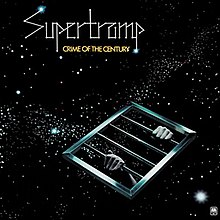Crime of the Century (album)
| Crime of the Century | ||||
|---|---|---|---|---|
 |
||||
| Studio album by Supertramp | ||||
| Released | 13 September 1974 | |||
| Recorded | February-June 1974 | |||
| Studio | Ramport Studios (South London), Scorpio Sound Studios (London), and Trident Studios (London) | |||
| Genre | Art rock,progressive rock | |||
| Length | 44:10 | |||
| Label | A&M | |||
| Producer | Ken Scott, Supertramp | |||
| Supertramp chronology | ||||
|
||||
| Professional ratings | |
|---|---|
| Retrospective reviews | |
| Review scores | |
| Source | Rating |
| AllMusic | |
| Robert Christgau | C+ |
| Sputnikmusic | 4/5 |
Crime of the Century is the third album by the English rock band Supertramp, released in September 1974. Crime of the Century was Supertramp's commercial breakthrough in both the US and UK, aided by the UK hit "Dreamer" and the U.S. hit "Bloody Well Right". It was a UK Top 10 album and a U.S. Top 40 album, eventually being certified Gold in the U.S. in 1977 after the release of Even in the Quietest Moments.... The album was Supertramp's first to feature drummer Bob Siebenberg (at the time credited as Bob C. Benberg), woodwinds player John Anthony Helliwell, bassist Dougie Thomson, and co-producer Ken Scott. The album has received critical acclaim, including its inclusion in Rolling Stone's "50 Greatest Prog Rock Albums of All Time".
The album's dedication reads "To Sam", which is a nickname for Stanley August Miesegaes, the Dutch millionaire who supported the band financially from 1969–72.
After the failure of their first two albums and an unsuccessful tour, the band broke up, and Rick Davies and Roger Hodgson recruited new members, drummer Bob C. Benberg, woodwinds player John Helliwell, and bassist Dougie Thomson. This new line-up were sent by their record label, A&M, in particular A&R man Dave Margereson (who would become their manager for the next ten years) to a seventeenth-century farm in West Dorset in order to rehearse together and prepare the album.
The album was recorded at a number of studios including Ramport Studios (owned by The Who) and Trident Studios with co-producer Ken Scott. While recording the album, Davies and Hodgson recorded approximately 42 demo songs, from which only 8 were chosen to appear on the album. Several other tracks appeared on later albums (Crisis? What Crisis?, ...Famous Last Words...).
...
Wikipedia
